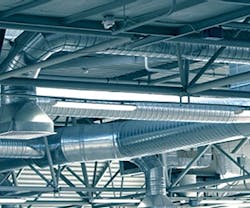Summer Tips for HVAC Distribution Components
With cooling season in full swing, are you getting frequent occupant complaints about hot or cold spots? Has a space just been renovated for different uses and occupancy? Do you find yourself constantly tweaking HVAC components just to maintain thermal comfort?
If so, you may need to employ ENERGY STAR’s testing, adjusting, and balancing (TAB) method on your distribution system.
HVAC components that distribute air and water for conditioning throughout your building need to be balanced and cleaned periodically. Using TAB, your system is regulated so that air and water flows match load requirements.ENERGY STAR offers guidelines for tuning your distribution system in its Building Upgrade Manual.
The TAB process begins with testing to evaluate the performance of equipment in its current state and make recommendations for improvements. Adjustments to flow rates of air or water are then made in order to balance the system and match loads throughout your facility.
TAB analysis usually includes a complete review of design documentation. Typical components and parameters to investigate include:
- Air system flow rates, including supply, return, exhaust, and outside airflow
- Water system flow rates for chillers, condensers, boilers, and primary and secondary heating and cooling coils
- Temperatures of heating and cooling delivery systems (air and water sides)
- Positions and functioning of flow-control devices for air and water delivery systems
- Control settings and operation
- Fan and pump speeds and pressures
The savings associated with a TAB investigation come from the reductions in energy used by the heating and cooling system and range up to 10% of heating and cooling costs.
Heat exchange equipment – usually consisting of heating and cooling coils installed in air handlers, fan coil terminal units, or baseboard radiators – should also be inspected and cleaned.
All surfaces and filters should be clean because dirty surfaces reduce heat transfer and increase pressure loss, thereby increasing energy use.
Also make sure that terminal fan coil units and baseboards are not blocked or covered with books, boxes, or file cabinets. In addition to being a fire hazard, blocked units prevent proper circulation and make heating and cooling inefficient.
Savings associated with cleaning coils and filters can range up to 10% also.
The full manual – which also includes information on project planning, project execution, as well as other tune-up opportunities – is available for download at www.energystar.gov.
